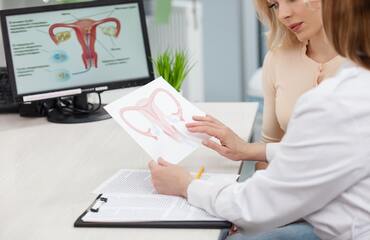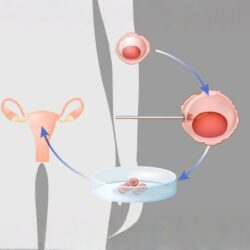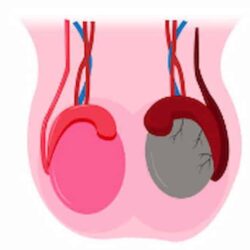Understanding Ovarian Torsion: Causes And Symptoms
Ovarian torsion occurs when an ovary twists around the ligaments that support it, potentially cutting off its blood supply. This condition can lead to severe pain and may require immediate medical attention to avoid serious complications, such as loss of the ovary. Understanding the causes and symptoms of ovarian torsion is essential for prompt diagnosis and treatment.
Several factors can contribute to the occurrence of ovarian torsion:
- Anatomical Factors: Some women may have anatomical variations, such as elongated ligaments, which can increase the risk of twisting.
- Hormonal Changes: Hormonal fluctuations during the menstrual cycle can lead to the enlargement of the ovaries, making them more susceptible to torsion.
- Cysts or Tumors: The presence of ovarian cysts or tumors can create additional weight and tension, increasing the likelihood of torsion.
- Trauma: Physical trauma or sudden movements can provoke ovarian torsion, particularly in active individuals.
Symptoms of ovarian torsion can vary but typically include:
- Severe Pelvic Pain: The most common symptom, often sudden and intense, may be localized to one side.
- Nausea and Vomiting: Accompanying symptoms that may occur due to severe pain.
- Changes in Menstrual Cycle: Some women may experience changes in their menstrual patterns, including delayed periods.
- Abdominal Pain: Pain may also radiate to the lower abdomen or back.
Recognizing these symptoms early on is crucial, as prompt medical intervention can significantly improve the chances of preserving ovarian function and overall reproductive health.
How Ovarian Rotation Occurs
Ovarian torsion occurs when the ovary twists around the ligaments that hold it in place, cutting off its blood supply. This twisting can be triggered by a number of factors, including anatomical abnormalities that make the ovary more mobile or changes in hormonal balance. Additionally, cysts or tumors on the ovary may increase its weight, further promoting the risk of rotation.
Once the ovary is twisted, the blood vessels that supply the affected area can become constricted. This can lead to swelling and eventual tissue damage if not treated promptly. In some cases, the rotation can be partial, allowing some blood flow to remain, but this does not eliminate the risk of complications.
In younger women and girls, ovarian torsion often occurs during physical activity or exercise, potentially due to the sudden jerking movements that may lead to a twist. Conversely, it can also happen during pregnancy due to various changes in the body. Recognizing risk factors is essential for early detection and treatment of ovarian torsion.
Awareness of the anatomy and function of the ovarian ligaments can help in understanding how this condition develops. The broad ligament, infundibulopelvic ligament, and ovarian suspensory ligaments all enable the ovary’s position, and any movement in these can facilitate torsion.
The process of ovarian rotation is complex but can be identified quickly with the right knowledge and understanding, allowing for timely intervention and better outcomes for women’s health.
Recognizing The Signs Of Ovarian Torsion In Women
Ovarian torsion can present with a variety of symptoms, which may vary in intensity and can be mistaken for other medical conditions. It’s essential for women to be aware of these signs to seek prompt medical attention should they occur. Here are the key symptoms to look out for:
- Sudden, Severe Abdominal Pain: This is often the most prominent symptom. The pain typically starts suddenly and usually occurs on one side.
- Pelvic Pain: In addition to abdominal pain, women may experience significant pelvic discomfort.
- Nausea and Vomiting: Accompanying the intense pain, nausea and vomiting may occur, potentially leading to dehydration.
- Changes in Menstrual Cycle: Some women may notice irregularities in their menstrual cycle, such as missed periods or unusually heavy bleeding.
- Fever: A fever may be present, signaling inflammation or infection.
- Pressure or Fullness in the Abdomen: A feeling of fullness or pressure may also be present alongside the pain.
Recognizing these signs early can significantly impact the outcome and treatment options for ovarian torsion. If you or someone you know experiences these symptoms, it is crucial to seek medical attention immediately, as timely intervention is essential to preserve ovarian function.
Emergency treatment for ovarian torsion is crucial, as timely intervention can significantly impact the likelihood of preserving ovarian function. Upon suspicion of ovarian torsion, immediate medical attention is essential. Healthcare providers typically conduct an ultrasound to confirm the diagnosis and assess blood flow to the affected ovary.
If ovarian torsion is confirmed, the primary treatment is surgical intervention. The procedure, often performed laparoscopically, involves untwisting the affected ovary and restoring its blood supply. In some cases, the surgical team may also secure the ovary to prevent future occurrences.
In certain situations, if the ovary has been without blood supply for too long, it may become necrotic, necessitating removal. The decision will depend on the extent of damage and the duration of torsion. Early surgical treatment increases the chances of preserving the ovary and maintaining fertility.
Post-surgery, patients may require pain management and monitoring for any complications. Regular follow-ups with a healthcare provider are recommended to ensure complete recovery and to address any subsequent concerns regarding ovarian health.
Untreated ovarian torsion can lead to serious complications, primarily due to the loss of blood supply to the affected ovary. When the blood flow is disrupted, the ovarian tissue may begin to die, leading to necrosis. This can cause severe pain and may require surgical intervention to remove the damaged ovary.
In severe cases, if the torsion is not addressed quickly, it can result in a complete loss of ovarian function. This not only affects fertility but can also lead to hormonal imbalances impacting a woman’s overall health.
Additionally, untreated ovarian torsion can potentially lead to the formation of scar tissue within the pelvis, which may complicate future pregnancies or result in chronic pelvic pain.
Prompt diagnosis and treatment are critical to minimizing the risk of these complications. Therefore, it is essential for women to be aware of the signs and symptoms associated with ovarian torsion and seek immediate medical attention if they suspect an issue.
Key Takeaways And Next Steps For Ovarian Health
Understanding ovarian torsion is crucial for maintaining ovarian health. Here are some key takeaways regarding this condition:
- Ovarian torsion is a medical emergency that requires prompt diagnosis and treatment to prevent complications such as loss of the ovary.
- Recognizing the symptoms—such as severe abdominal or pelvic pain—is vital for timely intervention.
- Factors like hormonal changes, structural abnormalities, or rapid physical activity can contribute to the risk of ovarian torsion.
- Regular check-ups with a healthcare professional can help monitor ovarian health and detect any underlying issues early on.
- Awareness of one’s body and its changes is essential for recognizing potential problems quickly.
Next steps for women regarding ovarian health include:
- Keeping a record of menstrual cycles and any abnormal symptoms to discuss with a healthcare provider.
- Engaging in conversations about family history of reproductive issues, which may influence personal risk factors.
- Prioritizing a healthy lifestyle with regular exercise and a balanced diet to support overall reproductive health.
- Seeking immediate medical attention if experiencing sudden, severe abdominal or pelvic pain.
By staying informed and proactive, women can take significant steps towards preserving their ovarian health and reducing the risk associated with conditions like ovarian torsion.








